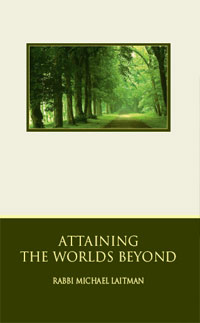Even for Spirituality, Habit Becomes Second Nature
Our bodies function automatically in accordance with the laws of their own egoistic nature and habit. If we constantly repeat to ourselves that we desire only spiritual ascent, then in the end we will desire it. The body, by virtue of these incessant exercises, will accept this desire as a natural one. It is often said that a habit becomes second nature.
In the state of a spiritual decline, we should hold on to the belief that “When Israel is in exile, the Creator is with them.”
When we are in a state of apathy and hopelessness, even the spiritual world presents no interest to us, because everything appears to exist on the level at which we exist at that moment.
Therefore, we must believe that this feeling is nothing more than our personal awareness, as we are presently in a state of spiritual exile and thus unaware of the Creator, who is also exiled from our awareness.
The Five Stages of Egoistic Development
The Light that emanates from the Creator goes through four stages before egoism is created. Only the last, the fifth stage (Malchut), is called creation because it perceives its own egoistic desires to delight in the Light of the Creator.
Thus, the first four stages are all qualities of the Light itself, through which He creates us. We accept the highest quality, that of the first stage, or the desire to delight a future creation, as the quality of the Creator Himself. At the end of the spectrum is the fifth stage of development, or the egoistical creation, which desires to counteract its own egoistical nature and to become akin to the first stage. Though attempts are made, they are only partially successful in this endeavor.
The first stage of egoism, which can counteract itself fully, is known as the world Olam Adam Kadmon.
The second stage of egoism, is the world Olam Atzilut.
The third stage of egoism, which forms a part of the fifth stage that can no longer be compared to either the first or the second stage, is the world Olam Beria.
The fourth stage of egoism, which forms a part of the fifth stage, has no strength to withstand itself, so as to be compared to the first, second, or third stages, but can only resemble the fourth stage of the development of Light. It is known as the world Olam Yetzira.
The remaining part of the fifth stage has no strength to aspire to be like any of the previous stages. It can only passively resist egoism by preventing itself from receiving pleasure (the action contrary to the fifth stage). This is known as the world Olam Assiya.
Ascension Is the Purpose of Creation
Every world has five sub-stages that are called Partzufim: Keter, Hochma, Bina, Zeir Anpin, and Malchut. Zeir Anpin consists of six sub-Sefirot: Hesed, Gevura, Tifferet, Netzah, Hod, and Yesod. After the creation of the five worlds, our material world—the realm below the world of Assiya was created and a human being was created in it.
The human being was endowed with a small portion of the egoistic qualities of the fifth stage. If human beings ascend in the process of spiritual development from the bottom to the top within the spiritual worlds, then the part of egoism that is in them and, likewise, all the parts of those worlds that they used for their ascent, become comparable with the first stage, with the quality of the Creator.
When the entire fifth stage elevates to the level of the first, then all the worlds will arrive at the purpose of creation.
Time, Space, and the Instruments to Correct Egoism
The spiritual cause of time and space is the absence of Light in the collective soul, where spiritual ascents and declines result in a sensation of time, and the place for the future Presence of the Creator’s Light gives an impression of space in our world.
Our world is affected by spiritual forces that impart to us a sensation of time caused by the change of their influence. Since two spiritual objects differing in their qualities cannot be as one spiritual object, they exert their influence one after the other, first the higher and then the lower, and so on. In our world, this produces a sensation of time.
We are endowed with three instruments for the task of successfully correcting our egoism: feelings, intellect and imagination. With regard to the spiritual matter and form, the matter is represented by egoism, while its form is determined by the opposing forces, corresponding to our own world.
Egoism and Altruism: Distance or Closeness to the Creator
We define delights and suffering as good and evil respectively. But spiritual suffering serves as the only source of development and progress of humankind. Spiritual redemption is perfection, received on the basis of strong negative sensations, which are received as pleasant ones.
Since the left line returns to the right one, the misfortunes, suffering, and pressures are transformed into happiness, pleasure, and spiritual freedom.
The reason for this is that in every object there are two opposing forces: egoism and altruism, which are experienced as remoteness from, or proximity to, the Creator.
There are many examples of this in the Bible: the sacrifice of Yitzhak, the sacrifices in the Temple, and so forth. (In Hebrew sacrifices are korbanot, a word that is derived from the word karov—to advance toward something).
The right line represents the essence of the spiritual object, whereas the left line is actually only that part of egoism that can be employed by joining it to one’s altruistic intentions.
 “The Layperson’s Guide to Performing Spiritual Corrections” is based on the book, Attaining the Worlds Beyond by Dr. Michael Laitman.
“The Layperson’s Guide to Performing Spiritual Corrections” is based on the book, Attaining the Worlds Beyond by Dr. Michael Laitman.

